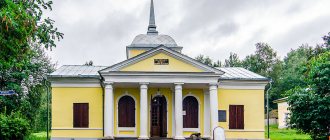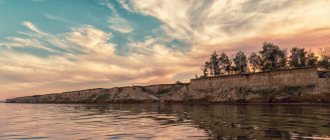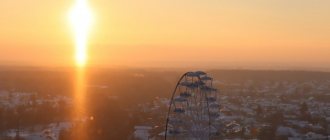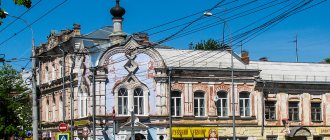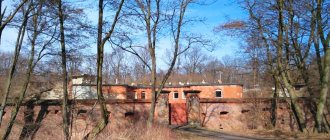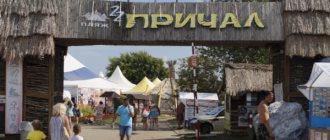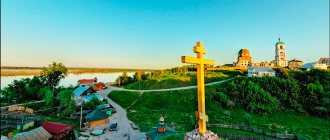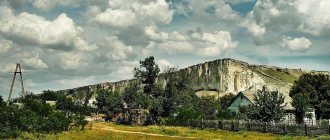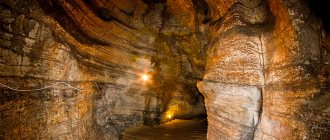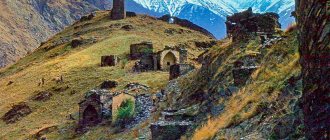The best attractions in the vicinity of Kolomna:
Bobrenev Monastery
Bobrenev Monastery
A few kilometers from the city lies the oldest monastic monastery in this region. The exact date of construction of the building is unknown; it was presumably built at the end of the 14th century by order of Prince Donskoy. Subsequently, several more churches made of stone and outbuildings appeared around the monastery.
An amazing place that helps you forget for a few hours and completely immerse yourself in an atmosphere of peace. The building is not only an important church building, but is also considered a valuable historical and architectural monument.
Address: Kolomna urban district, village of Staroye Bobrenevo
Working hours: Tuesday-Sunday from 9:00 to 18:00, Monday - day off
Free admission
Official website: https://bobrenev.ru/
Brusensky Assumption Monastery
The foundation of the monastery dates back to 1552, and is associated with the third campaign of Ivan the Terrible against Kazan. It is assumed that the king founded the monastery upon his return from a successful campaign. Initially, most of its buildings were made of wooden beams, so the monastery began to be called “timbered” or “Brusensky”. The first inhabitants of the original monastery were some participants in the victorious Kazan campaign.
Brusensky Assumption Monastery
During the Time of Troubles, the monastery experienced a decline. After the Time of Troubles, the monastery became a convent. Among the nuns there were also persons from noble families. After the abolition of the Kolomna diocese, the Brusensky Assumption Monastery was assigned to the Assumption Tula Monastery, and even the abbess and nuns were moved there. Then, at the request of the Kolomna residents, the Holy Synod reversed its decision.
The heyday of the monastery was the 19th century. During Soviet times, the monastery was closed. Its buildings suffered significant damage, and the nuns were expelled or repressed. Fortunately, large-scale restoration work has returned it to almost its original appearance.
The main building of the monastery is the five-domed Holy Cross Cathedral, erected in the mid-19th century. It became an adornment not only of the monastery, but of the entire Kremlin. White stone carved details stand out on the red brick walls of its façade.
The main relic of the Brusensky Monastery was a copy of the Kazan Icon of the Mother of God, lost in Soviet times. The list has now been recreated based on a copy found in the archives.
Address: Brusensky lane, 36.
What to visit in Kolomna for free:
John the Baptist Church
John the Baptist Church
The oldest temple in the Moscow region was allegedly built in the 14th century. Over the many years of its existence, the church, made of rough-hewn white stone, was rebuilt several times; all that remains of the original building is the foundation and partly the walls of the quadrangle. The bell tower was added to the temple at the end of the 18th century.
With the advent of Soviet power, the church was closed. The building was in disrepair for a long time; restoration work was completed in 1969.
The church is surrounded by many secrets and legends. According to one of them, a small block in the wall with an image of a fantastic beast is the seal of Batu Khan.
For a long time, the main temple hall was decorated with the “Angel of the Desert” icon; now you can admire the relic in the Tretyakov Gallery.
Address: Kolomna, st. Gorodishchenskaya, 102 a
Opening hours: daily from 8:00 to 17:00
Free admission
Official website: https://ioanpredkol.gradblagokolomna.ru/
Church of St. Nicholas on Posad
Church of St. Nicholas on Posad
One of the oldest in the city. Since 1990, it has been transferred to the ownership of the Russian Orthodox Old Believer Church.
The snow-white temple was built with donations from local residents in the first half of the 18th century. The architecture is dominated by the Moscow patterned style. Brick carvings decorate almost the entire building, and the upper part is decorated with 105 kokoshniks. The temple is crowned with 5 bathing towers with crosses.
Address: Kolomna, st. Posadskaya, 18
Opening hours: the church is open during worship hours
Free admission
Assumption Cathedral of Kolomna
Assumption Cathedral of Kolomna
The temple is built of white stone. It is decorated with 5 domes; above the main entrance rises an icon of the Mother of God, made in a mosaic pattern. Inside there are several dozen wall frescoes that were restored by the best masters.
Now they appear in their original form. Here is an iconostasis created at the end of the 18th century.
The cathedral has a rich history. For many centuries, great commanders, including Dmitry Donskoy and Ivan the Terrible, came here to ask for God's help. During Soviet times, storage facilities were located here, but a few years ago religious services began to take place again.
Address: Kolomna, st. Lazareva, 14
Opening hours: daily from 8:00 to 19:00
Free admission
Official website: https://cathedral.me/
Kuprin House
Kuprin House
The wooden building was built in the 19th century. It was never the writer’s property; the mansion belonged to his sister Zinaida Ivanovna. The woman was the wife of the local forester S. Nat. Currently, the old wooden house is for rent. The operating hotel welcomes everyone.
Alexander Ivanovich often came to stay with a relative. He wrote several of his famous works while in Kolomna, including hunting notes. During his lifetime, Kuprin adored animals, and therefore residents of the house can move into rooms with pets.
Address: Kolomna, st. Lazareva, 10
Opening hours: daily from 13:00 to 21:00
Free admission
Shevlyaginskaya basin
Shevlyaginskaya basin
An unusual monument in memory of the Kolomna water pipeline was opened in 2013 on Molochnaya Square. The city water supply system appeared in Kolomna in 1902 thanks to the honorary citizen of Kolomna - M. N. Shevlyagina. He became the first on the territory of the Moscow province. The interesting name “pool” was given to the speakers by local residents.
The cast-iron water tower rising on the square was created by modern craftsmen with utmost precision according to the drawings of the last century. It receives water from the city water supply. Following the tradition of our ancestors, during the grand opening of the monument, the water was blessed.
Address: Kolomna, Artilleristov proezd
Opening hours: 24 hours a day
Free admission
Church of the Epiphany in Gonchary
Church of the Epiphany in Gonchary
The beautiful temple was built in the first half of the 19th century. on the foundation of an ancient church built in the 16th century. Initially, the shrine was called the Church of the Savior Not Made by Hands, and since 1680 - the Epiphany Church.
This religious building was the only one on the territory of Kolomna in which services did not stop even during Soviet times.
Inside the cathedral, ancient frescoes have been preserved, miraculous icons and holy relics are kept. The uniqueness of the attraction lies in the fact that it was here that St. Philaret of Moscow was born. At different periods, the saint's great-grandfather, grandfather and brother served in the church.
Address: Kolomna, st. Goncharnaya, 8
Opening hours: the church is open during worship hours
Free admission
Official website: https://bogoyavlenie.prihod.ru/
Church of St. Michael the Archangel
Church of St. Michael the Archangel
The temple was erected in 1700 on the site where a wooden church had stood for 400 years. The building was rebuilt according to the design of the capital's architect Shestakov in 1828. For a long time, no services were held in the Church of St. Michael the Archangel, and the building housed one of the branches of the Local History Museum. At the beginning of the 21st century. reconstruction was carried out and since 2007 the temple has been operating again.
The largest church in Kolomna is made in the style of classicism. The rectangular temple is crowned with a rotunda with a semicircular dome. The main entrance is decorated with a beautiful snow-white pediment, and on both sides of the door there are 2 columns. The most magnificent view of the temple opens from the Kolomenka River.
Address: Kolomna, st. Civil, 71
Opening hours: daily from 8:00 to 18:00
Free admission
Mozgov's House
Mozgov's House
The building was erected in the 19th century. Together with the Church of the Exaltation of the Cross and the Lukovnikov House, it forms a complex of buildings made in the Empire style. Over the course of many years of its existence, the house constantly changed tenants; it was named after one of the most prominent owners.
The architectural monument allows you to return to the atmosphere of the past. There is a basement under the one-story building. The original layout has been preserved inside.
The living room is decorated with corner tiled stoves; double doors leading into the rooms correspond to the basic style. Sunlight enters the house through wooden window frames.
Address: Kolomna, st. Lazhechnikova, 5
Opening hours: daily
Free admission
Tikhvin Temple
Tikhvin Temple
The church was erected at the end of the 18th century. Subsequently, it was completed more than once. In the middle of the next century the temple was expanded. The beginning of the new century was a difficult time.
Almost the entire interior of the building was destroyed, and several decades later large-scale restoration work began. New bells were raised above the temple, one of which was created in Voronezh.
The unique building will interest not only fans of history and architecture, but will also attract the attention of curious tourists who want to learn more about the development of the city.
Address: Kolomna, st. Lazareva, 14
Opening hours: daily from 7:00 to 19:00
Free admission
Official website: https://kolomna-sobor.gradblagokolomna.ru/xramy-prixoda/tixvinskij-xram/
Epiphany Staro-Golutvin Monastery
Epiphany Staro-Golutvin Monastery
On the eastern outskirts of the city is one of the oldest sights of Kolomna. The Golutvin Monastery has stood at the confluence of the Moscow River and the Oka since 1385. Its founders are considered to be Dmitry Donskoy and Sergius of Radonezh. The word “Old” appeared in the name of the monastery after the founding of the Novo-Golutvin Holy Trinity Monastery in the 18th–19th centuries.
On the territory of the monastery ensemble rises the Epiphany Church, which houses the relics of Bishop Kolomna and the confessor Theodosius. The ancient temple in honor of Sergius of Radonezh also deserves the attention of guests.
Its main attraction is the main altar, on which 2 angels are installed, in one of them particles of the Honest Life-Giving Cross of the Savior are stored, and in the second - small elements of the Crown of Thorns.
Address: Kolomna, st. Golutvinskaya, 11
Opening hours: daily from 7:00 to 17:00
Free admission
Official website: https://starogolutvin.ru/
Tikhvin Church
The Tikhvin Church was originally built in the 18th century. A century later, it was dismantled and a new five-domed one was built in the pseudo-Russian style. From the east it adjoined the bell tower.
Tikhvin Church
The church is named after the icon of the Mother of God, painted by the Evangelist Luke, found near the city of Tikhvin. The new church had three altars: the main one, in the name of this icon, the left one - in honor of Simeon the God-Receiver and Anna the Prophetess, and the right one, dedicated to the icon of the Mother of God “Quench my sorrows”.
During Soviet times, the church was closed, the domes were demolished, and the interior was destroyed. After the church was returned to the believers, Kolomna craftsmen carried out large-scale restoration work. Divine services in the church resumed even earlier than in the Assumption Cathedral.
Where to go in Kolomna and what else to see:
Kolomna Local Lore Museum
Kolomna Local Lore Museum
From its foundation in 1936 until 2005, it occupied the building of the Church of the Archangel Michael. In 2006, the museum's funds were transported to a magnificent merchant estate built in the mid-19th century.
The local history museum has more than 25 thousand exhibits introducing guests to the history, nature and culture of Kolomna. The walls of one of the exhibition halls are decorated with paintings by famous Russian painters Aivazovsky, Vasnetsov and Pimenov.
The pride of the Kolomna Local Lore Museum is its collection of archaeological finds dating back to the Bronze, Stone and Iron Ages.
Address: Kolomna, st. Lazhechnikova, 15
Opening hours: daily from 10:30 to 16:30, from Monday to Tuesday and on the last Friday of each month, the museum is closed
Entrance: for adults – 40 rubles, for children – 25 rubles.
Official website: https://kolomnamuzej.ru/
Museum of Organic Culture
Museum of Organic Culture
One of the most visited places in the city, attracting the attention of fans of Russian art. The museum is located on the site of the former estate of the Ananyin family. Subsequently it belonged to the merchant Lvov.
In 2011, a decision was made to assign the building the title of cultural and historical monument. Inside there are several hundred paintings by contemporary artists working in certain styles that preserve the main traditions of the Russian avant-garde.
The exhibitions will allow you to get closer to the concept of organic culture. The building where the gallery is located is also interesting from an architectural point of view.
Address: Kolomna, st. Kazakova, 10
Opening hours: Wednesday – Sunday, from 12:00 to 18:00
Entrance: ticket price per person – 200 rubles.
Official website: https://museumart.ru/
Skating
Skating
The largest multifunctional sports complex in the Moscow region. On an area of 70 thousand m2 there is an ice arena, a gym and games room, a pneumatic shooting range, an outdoor stadium, a medical center for rehabilitation and prevention, a large swimming pool, an office space for the press center, a beautiful winter garden, a mini hotel and a cafe.
The ice arena is one of the most visited and fastest skating rinks in the world. International competitions have been held here several times, and Russian speed skating championships are held every year.
The stands can comfortably accommodate more than 6 thousand visitors. The Winter Garden is also of interest to tourists.
Address: Kolomna, emb. Kolomenki River, 7
Opening hours: You can purchase a ticket at the box office any day. On weekdays - from 8:30 to 20:45, on weekends - from 8:30 to 19:45
Entrance: visiting the pool - 180 rubles, skating - 200 rubles, rental - 120 rubles.
Official website: https://kolomna-speed-skating.com/
Museum of Military Glory
Museum of Military Glory
Located in Memorial Park, in an interesting building with a red facade representing the Victory Banner. The spacious exhibition halls display several exhibitions that introduce visitors to the military history of the city from different periods. Most of the exhibits were kept in the home archives of townspeople for a long time.
Particularly noteworthy is the diorama - an 82-mm mortar, the design of which was created by employees of the Kolomna Engineering Bureau. The pearl of the exhibition is the electronic Memory Book.
Address: Kolomna, st. Invincible, 1
Opening hours: Wednesday – Saturday from 10:30 to 16:30. Sunday, Monday and last Friday of the month are days off
Entrance: 100 rubles, discount ticket – 50 rubles. Children under 6 years old – free
Official website: https://kolomna-memorial.ru/
Museum "Kalachnaya"
Museum "Kalachnaya"
The unusual and most “tasty” museum of Kolomna is located in a beautiful building erected in the first half of the 19th century. The founders tried to recreate in the hall a warm atmosphere corresponding to the life of the 19th – 15th centuries.
In a double-hearth Russian oven, built by modern craftsmen according to ancient drawings, the most aromatic and appetizing rolls in the Moscow region are baked. The dough for the famous pastries is prepared according to ancient Russian recipes, and in order to give the finished products a delicate light crust, the oven is heated only with birch firewood, cleared of bark.
During the theatrical excursion, visitors will learn many interesting facts about the history of the appearance of kalach, the secrets of the dough and see all the stages of preparation. After visiting the museum, guests should stop by the shop where you can buy freshly baked kalach.
Address: Kolomna, st. Zaitseva, 14
Opening hours: daily from 10:00 to 20:00
Entrance: for adults – 400-500 rubles, for children – 300-400 rubles.
Official website: https://kolomnakalach.ru/
Museum "Kuznechnaya Sloboda"
Museum "Kuznechnaya Sloboda"
Numerous exhibitions feature wooden and forged objects that were created by talented craftsmen several centuries ago. Stored within the walls of the museum are dozens of types of all kinds of weapons, previously used armor of warriors and household utensils previously used by local residents.
Kuznets I.G. Lebedev is considered the founder of the museum. He was the first to begin collecting a collection of rare exhibits, traveling throughout the country. In the future, he furnished the mansion in the appropriate style and opened a museum that allows you to get acquainted with the culture of the Kolomna region.
Address: Kolomna, st. Grazhdanskaya, 84
Opening hours: daily from 10:00 to 18:00, closed on Mondays
Entrance: 100 rubles, excursion – 1000 rubles.
Official website: https://xn--80aacmclulpbnb9aw7d8g.xn--p1ai/
House of Posad Crafts
House of Posad Crafts
The art workshop is located near the Pastila Museum. The venues host several permanent exhibitions and temporary ones.
Visitors have a unique opportunity not only to learn interesting facts about traditional Kolomna crafts, but also to attend master classes in pottery, toy making, or temporarily become a real blacksmith.
There is a forge in the House of Posad Crafts. In the souvenir shop, those interested can purchase memorable gifts made by the owners of the art workshop.
Address: Kolomna, st. Posadskaya, 12
Opening hours: on weekdays - by appointment, on weekends - from 12:00 to 18:00
Entrance: for adults – 150 rubles, for children – 100 rubles.
Museum-residence “Artkommunalka. Erofeev and Others"
Museum-residence “Artkommunalka. Erofeev and Others"
One of the most extraordinary and interesting museums in the city. Visitors have the opportunity to visit a real communal apartment, where the interior fully corresponds to the Soviet era.
The museum has several exhibition halls and a stage where modern interactive games and performances take place. An art residence is equipped in a separate room, where artists and writers live and create from time to time.
Address: Kolomna, st. October Revolution, 205
Opening hours: daily from 10:00 to 20:00
Entrance: 200 rubles, excursion – 300 rubles.
Official website: https://artkommunalka.com/
Museum of Origins “This money is Kolomsk”
Museum of Origins “This money is Kolomsk”
The landmark is located in the Pyatnitskaya Tower. The opening of the museum was initiated by local historian and numismatist M. Amosov.
The museum consists of 2 levels. On the top there is a hall dedicated to the history and traditions of the Kolomna lands. Significant coins for Rus' are stored here in separate display cases: a coin of the Golden Horde, a Kolomna pullo, a coin of Vasily III, a pound of Uzbek Khan.
On the first level (basement) you can see items that were used as means of payment in Rus' in the 10th century. A collection of famous treasures and ancient piggy banks are also exhibited here.
Address: Kolomna, st. Zaitseva, 14
Opening hours: daily from 10:00 to 20:00
Entrance: 200 rub.
Museum "Secrets of Kolomna mead"
Museum "Secrets of Kolomna mead"
Kolomna has been considered a beekeeping center since ancient times. Visitors to the interactive museum will learn all about the valuable qualities of honey, the secrets of preparing ancient Russian drinks, the main ingredient of which is honey.
Guests will enjoy a fascinating and interesting excursion “Secrets of Kolomna mead”. Tourists will learn not only the secret of the name mead, but will also see all the stages of preparing a truly Russian drink, and will also become participants in a luxurious feast. Those interested can walk through the forest with a beekeeper and learn to distinguish real honey from fake.
Address: Kolomna, st. October Revolution, 182 A
Opening hours: daily from 9:00 to 19:00
Entrance: for adults – 300 rubles, for children – 250 rubles.
Official website: https://medovusha.ru/
Private gallery “Museum of your favorite toy”
Private gallery “Museum of your favorite toy”
A unique museum opened in the city in 2014. Its founder was a local resident and collector, Irina Kulikova. The owner collected the teddy bears, dolls, and games presented in the exhibition hall for several years.
The oldest exhibit is a doll made in 1890. The remaining toys were made by craftsmen of the late 19th – early 20th centuries. In the museum you can see Teddy bears created by Kulikova. It was these funny animals that gave the founder the idea of opening a Museum of her favorite toy.
Address: Kolomna, st. Posadskaya, 11
Opening hours: Thursday - Friday - by appointment, Saturday - Sunday from 11:00 to 18:00
Entrance: ticket – 250 rubles, excursion – 800 rubles.
Official website: https://www.kolomnatoy.ru/
Estate of the Lazhechnikov merchants
Estate of the Lazhechnikov merchants
The building, built at the turn of the 18th-19th centuries, houses one of the many branches of the city local history museum. The exposition of the exhibition halls is dedicated to the famous writer I.I. Lazhechnikov.
Museum guests will be treated to a fascinating excursion in the form of an interactive performance. In Part I, visitors will learn interesting facts about the life and activities of the owner of the estate, and in Part II - the secrets of preparing the famous Kolomna delicacy - pastila.
Address: Kolomna, st. October Revolution, 192 A - 194
Opening hours: Wednesday – Sunday from 10:30 to 16:30. From Monday to Tuesday and on the last Friday of the month the estate is closed
Entrance: 100 rub.
Museum of Flax and Life of Russian Women
Museum of Flax and Life of Russian Women
Numerous exhibitions located in a two-story building present rare items collected by Kolomna native N. Ryabtseva. First, the woman became the owner of a small flax store, after which she decided to open a museum that anyone can visit.
During the excursion, guests will see items of home textiles and will be able to touch ancient spindles, spinning wheels and other types of weaving equipment. Several dozen folk costumes are collected within the walls of the museum.
Address: Kolomna, Square of Two Revolutions, 1
Opening hours: daily from 9:30 to 19:00
Entrance: without a guided tour – 150 rubles, with a guided tour – 250 rubles.
Museum-Estate “House of the Samovar”
Museum-Estate “House of the Samovar”
Numerous exhibitions present a private collection of the Burov family's everyday life. The excursion will give you the opportunity to get to know Russian culture better, visit a real Russian hut and learn more about samovars, their differences and methods of use.
Within the walls of the museum there are collected about 4 hundred different types of samovars, in addition, visitors will get acquainted with other ancient objects. These include various kitchen utensils. In one of the rooms there is a traditional Russian stove.
On the territory of the complex there is also a decorated cafe, where you can try dishes prepared according to family recipes.
Address: Kolomna, st. Posadskaya, 11
Opening hours: Monday to Friday from 10:00 to 18:00, on weekends - until 19:00
Entrance: for adults – 400 rubles, for children – 200 rubles. Up to 7 years – free
Official website: https://domsamovara.ru/
Ozerov's House
Ozerov's House
The cultural center occupies a beautiful building in the classicist style, considered one of the most perfect monuments of civil architecture in Kolomna. The landmark was named in honor of the Honorary Citizen of the city, merchant of the 1st guild A. S. Ozerov, who was the last to own the mansion.
The first exhibition was held in 1980, and to date there have been more than 800 of them.
There are permanent exhibitions in the Ozerov House: The Epic Cycle (works by K. Vasiliev), Here is the Russian Spirit (wooden sculptures by A. Leonardov), an exhibition dedicated to the life and work of the artist M. Abakumov.
Address: Kolomna, st. Krasnogvardeyskaya, 2
Opening hours: daily from 8:00 to 20:00
Entrance: 100 rubles, discount ticket - 50 rubles.
Official website: https://www.domozerova.ru/
Pastila Museum
Pastila Museum
In 2008, an unusual museum opened its doors, where anyone can learn the process of preparing the popular sweet and even try it. It is located on the site of a former merchant shop, which was built in the 18th century.
The museum complex includes a production workshop and laboratory, a gift shop and a garden. Museum staff introduce visitors to the methods of preparing different types of marshmallows. Recipes for sweets have been passed down from generation to generation, but their technique has never changed.
At the end of the tour, guests will have tea and tasting. After visiting, everyone can buy souvenirs and take photos.
Address: Kolomna, st. Posadskaya, 13a
Opening hours: daily from 10:00 to 20:00
Entrance: for adults – 400 rubles, for children – 300 rubles. On weekends the cost increases by 100 rubles.
Official website: https://kolomnapastila.ru/
Museum "Kolomensky Gramophone"
Museum "Kolomensky Gramophone"
It was no coincidence that the original museum appeared in Kolomna, because the All-Union Gramophone Factory was opened here in 1933. The opening ceremony of the museum took place on May 1, 2022 and was timed to coincide with a historical event - on this day in 1934 the first 10 gramophones were assembled.
The museum's collection includes not only portable gramophones created in the workshops of the Kolomna Gramophone Factory, but gramophones, music boxes, phonographs created by masters from different countries. During the tour, visitors can enjoy the sound of the exhibits.
Address: Kolomna, st. Lazhechnikova, 3a
Opening hours: Wednesday – Sunday from 11:00 to 17:00, Saturday – from 10:00 to 19:00, Monday and Tuesday – days off
Entrance: for adults – 200 rubles, for children – 100 rubles.
Official website: https://xn--80ajbkfdbgjlfcbim2aw1b.xn--p1ai/
Novogolutvin Holy Trinity Monastery
On the territory of the current monastery since the 14th century. Kolomna diocese was located. It included the Bishop's House and Corps, the Trinity Church and the Theological Seminary. At the very end of the 18th century. By imperial decree the diocese was abolished. Church authorities promptly transferred the monks of the Epiphany Golutvinsky Monastery to the vacated premises in order to preserve these structures for the church. From this moment on, the Kremlin Holy Trinity Monastery began to be called Novogolutvin, and the city Epiphany - Starogolutvin.
By the middle of the 19th century. New churches and a 55-meter yellow bell tower appeared on the territory of the monastery. During Soviet times, the monastery was closed, but in 1977 its premises began to be restored. A decade later, the monastery was returned to the Russian Orthodox Church, but it became a women's monastery.
The main building of the monastery is the Church of the Holy Trinity in the Russian Baroque style. Elegant windows decorated with crimson trim stand out on the white stone walls. In the background of the photo you can see the top of a beautiful light yellow bell tower.
Novogolutvin Holy Trinity Monastery
The nuns created the mosaic floors and mahogany iconostasis with their own hands. Thanks to the efforts of restorers who removed 12 layers of paint, beautiful 19th-century painting can once again be seen on the walls and ceiling.
In 1990, in the basement of the Trinity Church, a new church was consecrated in honor of Blessed Xenia of St. Petersburg. The church is famous for its unusual ceramic iconostasis made by the nuns.
Now over 80 nuns and nuns live in the monastery, and not only from Russia. They lead a fairly active lifestyle. The monastery has an Orthodox medical center with nun doctors, as well as a dog kennel where rare Mongol-Buryat dogs and Central Asian shepherd dogs are bred and kept. The nuns embroider and work in icon painting, ceramics and carpentry workshops. The church choir travels to services in other churches in Russia, and even beyond its borders.
Address: st. Lazareva, 11A.
FAQ
Where can you go with children in Kolomna? Museum "Kolomensky Gramophone", Museum of Marshmallow, Museum-Estate "House of the Samovar", Private Gallery "Museum of Favorite Toys".
What can you see in Kolomna for free? Memorial Park, St. John the Baptist Church, St. Nicholas Church on Posad, Kolomna Assumption Cathedral, Kuprin House.
4 main attractions of Kolomna that are definitely worth a visit? Cathedral Square, Kolomna Kremlin, Pyatnitsky Gate, Monument to Dmitry Donskoy.
Kolomna Kremlin
In the 16th century The Kremlin's stone walls with a perimeter of 2 km replaced the existing wooden ones. Their height reached 21 m, and their thickness was 4.5. Fragments of walls and seven of the originally built 17 towers have survived to this day. It is sad that the townspeople themselves actively participated in the dismantling of medieval walls for building materials. This vandalism was stopped only after a special decree of Nicholas I.
One of the surviving towers is called Kolomenskaya or Marinkina. The second name is associated with the version according to which an active participant in the Time of Troubles, the wife of False Dmitry, Marina Mnishek, was imprisoned and died in it.
Some architectural details, similar to northern Italian fortresses, give reason to believe that the Italian architect Aleviz Fryazin, who also worked in the Moscow Kremlin, participated in the construction of the Kolomna Kremlin.
Kolomna Kremlin
Religious, historical and ordinary residential buildings coexist on the territory of the Kremlin. Here are the Assumption Cathedral, Novolutvinsky and Assumption Brusensky convents and churches - Tikhvin, Resurrection and Holy Cross. In the center of the Kremlin is Cathedral Square. Its architectural ensemble was formed over two centuries by the sequential construction of the Assumption Cathedral, its bell tower, then the gate bell tower of the Novoglutvin Monastery, and, finally, the Tikhvin Church. Already in our century, a monument to the creators of the Cyrillic alphabet, Cyril and Methodius, appeared on Cathedral Square.
To make it easier to move around the rather vast territory of the Kremlin, visitors can rent... scooters. The first hour of rental will cost 200 rubles. for adults, and 150 rub. for children, and every subsequent hour - 100 rubles. There are guided tours around the Kremlin. Its cost for a group of up to 6 people is 1,500 rubles.
Best hotels in Kolomna
Related materials:
- 33 attractions of Bakhchisaray that are worth visiting
- 29 best attractions in Orel,…
- 38 sights of Pskov recommended for…
- 31 attractions of Novorossiysk to visit
- 37 must-see attractions in Dubai
- 26 attractions of Svetlogorsk that…
- 40 attractions in Limassol that are worth seeing
- 37 attractions of Sukhum that are worth seeing
- 43 best attractions in Minsk,…
Did you like the article? Share with friends:
2
Epiphany Starogolutvin Monastery
In the 15th century, at the confluence of the Oka and the Moscow River, the Epiphany Golutvin Monastery was founded. It is believed that this event occurred with the participation of Dmitry Donskoy and Sergius of Radonezh after the conclusion of peace between the two Russian principalities - Moscow and Ryazan. The unusual name is associated with the Golutvino area. It is assumed that the word “golutva” means a forest clearing (on the road from Kolomna to the Oka crossing).
Epiphany Starogolutvin Monastery
At the very end of the 18th century, after the abolition of the Kolomna diocese and the transfer of part of the brethren to the territory of the Kremlin, the monastery began to be called Starogolutvin. Its main temple is the Epiphany Cathedral. The current men's monastery also houses the Church of St. Sergius of Radonezh and the Vvedensky Gate Church.
Monastery address: st. Golutvinskaya, 11. It is open to the public, and donations are welcome.
"Secrets of Kolomna mead"
Medovushey in Rus' was a cellar for storing honey-based supplies and ripening honey-based intoxicating drinks, in particular mead.
There was such a cellar in almost every boyar or merchant house. The “Secrets of Kolomna mead” museum is located in the restored wine cellars of a 19th century merchant house.
Museum "Secrets of Kolomna mead"
The museum is a kind of symbiosis of antiquity and modern technology. Guests who descend into the cellar are greeted by a virtual housekeeper-guide and a very real mead maker.
After a story about the honey traditions of Kolomna, visitors, under the guidance of a mead maker, prepare honey whipping and taste different types of honey. After this, in the Golden Hive store you can purchase honey products - gingerbread, syrups, balms, wines.
Address: st. October Revolution, 182A, opening hours - from 9 to 19 hours. The visit is carried out in the form of group excursions. Individual tourists can join one of the groups by pre-registering on the museum’s website (medovusha.ru) or by calling the numbers listed there. The cost of the excursion for adults is 350 rubles, and for children – 250.
Museum "Kolomensky Kalach"
Similar to Kolomenskaya Pastila, this establishment is a symbiosis of production, museum and cafe.
Museum "Kolomensky Kalach"
The history of the production of rolls dates back to the 16th century. The kalachniks who baked them were considered the bread elite, into whose guild ordinary bakers were not allowed. Visitors also get acquainted with versions of the origin of the most common weight-bearing rolls in former times. It was believed that the hole was used to hang it on a fixed horizontal stick in the pantry, making the rolls out of reach of mice. According to another version, this form allowed ordinary people to eat a “weight” while working without washing their hands, and then throw away the holding “handle.”
The Kalachnaya Museum is located in a restored stone mansion from the 19th century. To bake kalachi, a double-hearth Russian oven is used, heated exclusively with birch firewood. The culmination of the excursion is tasting kalachi with butter and tea.
Address: st. Zaitseva, 14, opening hours: from 10 to 18 hours. Ticket price – 350 (on weekends and during the high tourist season – 400) rubles. There is an additional fee of 250 rubles for the excursion.
Bobrenev Monastery of the Nativity of the Virgin Mary
This monastery is located in the village of Staroye Bobrenevo adjacent to Kolomna on the other bank of the Moscow River. Its panorama is clearly visible from the Kremlin Cathedral Square.
Bobrenev Monastery of the Nativity of the Virgin Mary
The monastery was built by Dmitry Donskoy as gratitude to the Mother of God for the victory in the Battle of Kulikovo. In the 18th century The monastery lost its independence and became part of Novoglutvin. In the next century, the blue and white Feodorovskaya Church was built on the territory of the monastery. It houses the famous icon of the same name of the Mother of God, which was considered the patroness of the Romanov royal dynasty. (That is why, when adopting Orthodoxy, non-Russian wives of autocrats received the patronymic “Feodorovna.”)
There are two main churches in the monastery - the Nativity of the Virgin Mary (in the background) and Feodorovskaya. The acoustics of the Church of the Nativity of the Virgin Mary is unique: it creates the illusion of polyphonic singing.
The monastery is free to visit: donations are welcome.
Museum "Kuznechnaya Sloboda"
Another relatively young Kolomna museum is “Kuznechnaya Sloboda”, opened in 2010.
The museum's exhibition includes seven thousand blacksmith items. Their best examples approach the level of art. Here you can see military armor from the pre-Mongol period to the last century, as well as former household items - scales, old kettles, irons.
Museum "Kuznechnaya Sloboda" in Kolomna
Address: st. Grazhdanskaya, 84. Trams No. 1, 3, 7 and 9 go here. There is no fee for visiting, but tourists can leave a donation if they wish.
Coat of arms
The coat of arms of Kolomna is presented in the form of a French shield. In an azure field there is a silver column on a green hill. The figure is a symbol of greatness, strength, and reliable support. The firmament is thinly bordered with gold. The structure is topped with a crown flanked by two yellow six-pointed stars. Two of their rays are facing upward. Precious metal embodies wealth, justice, and generosity.
The artistic composition was adopted by decision of the City Council of Deputies dated May 22, 2002 No. 20/7 (as amended on June 18, 2003 No. 23/5).
